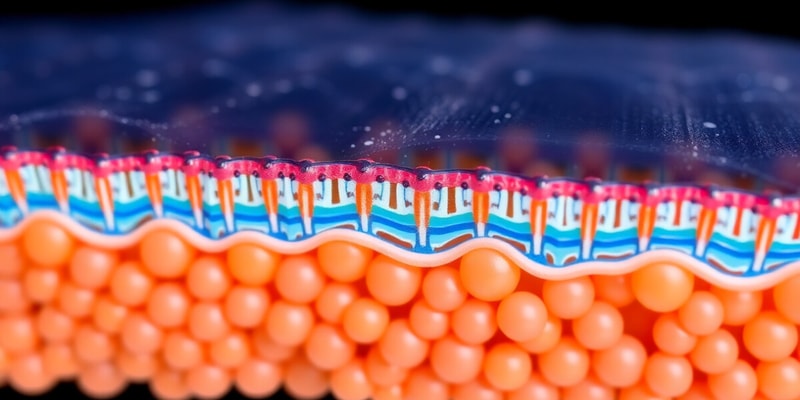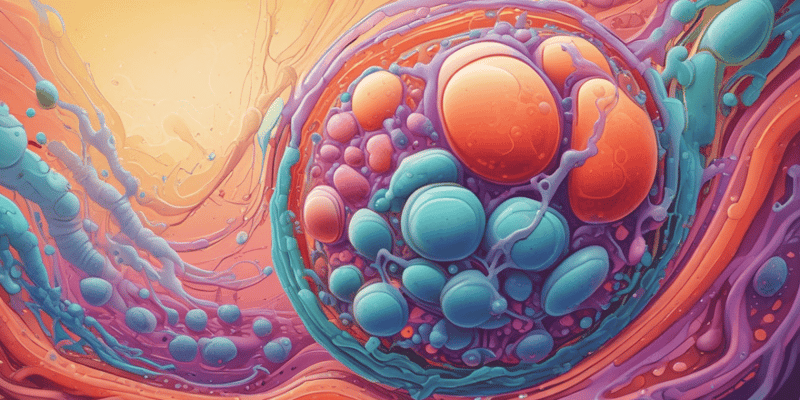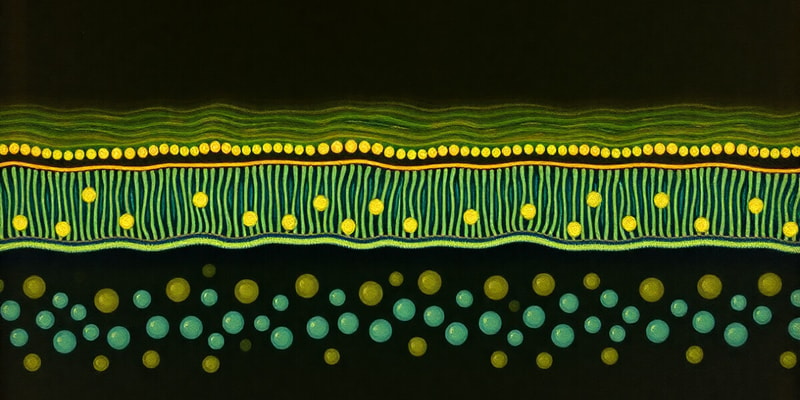Podcast Beta
Questions and Answers
What role does cholesterol play in the fluidity of the cell membrane?
Which statement correctly describes the structure of the cell membrane?
What explains why saturated fatty acids make the membrane less fluid?
What happens to the fluidity of the membrane when unsaturated fatty acids are present?
Signup and view all the answers
Which of the following correctly describes amphipathic molecules?
Signup and view all the answers
Which component of the cell membrane acts as an identification tag?
Signup and view all the answers
Why are saturated fats often referred to as 'bad fats'?
Signup and view all the answers
What is the typical consistency of cell membranes at room temperature?
Signup and view all the answers
What is the main role of membrane proteins?
Signup and view all the answers
Which type of protein is entirely located on the surface of the membrane?
Signup and view all the answers
What characteristic allows hydrophobic molecules to pass through the lipid bilayer easily?
Signup and view all the answers
What is the main function of carbohydrates found on the exterior surface of the cell membrane?
Signup and view all the answers
What defines the selective permeability of a cell membrane?
Signup and view all the answers
Which of the following substances would be expected to pass through the lipid bilayer most easily?
Signup and view all the answers
Which type of transport protein specifically binds to substances and facilitates their movement across the membrane?
Signup and view all the answers
What role do glycolipids play in cell membranes?
Signup and view all the answers
What is the role of enzymes in cellular reactions?
Signup and view all the answers
What does the term 'activation energy' refer to?
Signup and view all the answers
Why do enzymes not catalyze non-spontaneous reactions?
Signup and view all the answers
What determines the specificity of an enzyme's function?
Signup and view all the answers
How does the optimal functioning of an enzyme depend on environmental conditions?
Signup and view all the answers
What is the primary characteristic of passive transport?
Signup and view all the answers
In a hypertonic solution, what effect does osmosis have on animal cells?
Signup and view all the answers
How does osmosis differ from regular diffusion?
Signup and view all the answers
What is the role of the contractile vacuole in the protist Paramecium?
Signup and view all the answers
Which statement correctly describes isotonic environments for marine animals?
Signup and view all the answers
Which type of molecules typically utilize facilitated diffusion to cross membranes?
Signup and view all the answers
Why are plant cells considered happiest in hypotonic solutions?
Signup and view all the answers
In active transport, what is primarily required for molecules to move across the membrane?
Signup and view all the answers
What type of transport requires energy to move solutes against a concentration gradient?
Signup and view all the answers
What is the primary source of energy used in active transport mechanisms like the Na+/K+ pump?
Signup and view all the answers
What process describes the movement of large molecules into the cell?
Signup and view all the answers
Which type of energy is defined as the energy stored due to an object's position?
Signup and view all the answers
Which of the following statements accurately describes the first law of thermodynamics?
Signup and view all the answers
What type of system allows for energy and matter to be exchanged with its surroundings?
Signup and view all the answers
What is the term for the energy associated with the motion of molecules?
Signup and view all the answers
Which sequence correctly describes the transformation of energy in living cells?
Signup and view all the answers
Study Notes
The Cell Membrane
- The cell membrane acts as the boundary between the cell's interior and the external environment.
- Controls what enters and exits the cell.
- Organizes the cell's chemical reactions.
- Contains groups of enzymes that work in metabolism.
The Lipid Bilayer
- Phospholipids form a stable bilayer in water.
- The heads of the phospholipids face outwards towards the water.
- The tails face inwards away from the water.
- Membrane components are amphipathic, meaning they have both hydrophilic and hydrophobic properties.
Cell Membranes Structure
- The cell membrane is a fluid mosaic of lipids and proteins.
- Lipid molecules form a flexible bilayer.
- Protein molecules are embedded in the plasma membrane.
- Carbohydrates act as cell identification tags on the surface.
Membrane Fluidity
- Cell membranes have the consistency of salad oil at room temperature.
- Lipids have rapid lateral movement.
- Lipids rarely flip-flop between layers.
- Membranes must be fluid to function properly.
- Fluidity depends on the composition of lipids.
Saturated Fatty Acids
- All C-C bonds are single bonds.
- Straight chains allow for maximum interaction between fatty acid tails.
- Makes the membrane less fluid (more viscous).
- Solid at room temperature.
- Example: "Bad Fats" like animal fats that clog arteries.
Unsaturated Fatty Acids
- Some C-C bonds are double bonds.
- Bent chains space tails apart.
- Makes the membrane more fluid.
- Liquid at room temperature.
- Example: "Good Fats" like vegetable fats that do not clog arteries.
Cholesterol
- Cholesterol acts as a fluidity buffer.
- It has different effects on membrane fluidity at different temperatures.
- At warm temperatures, it restrains movement of phospholipids.
- At cool temperatures, it maintains fluidity by preventing tight packing of phospholipids.
Membrane Proteins
- Membranes are a mosaic of different proteins embedded in the lipid bilayer.
Peripheral Proteins
- Entirely on the membrane surface.
- Ionic and H-bond interactions with hydrophilic lipid and protein groups.
Integral Proteins
- Possess hydrophobic domains that are anchored to hydrophobic lipids.
- Span the membrane.
- Contain both hydrophobic and hydrophilic regions.
Membrane Carbohydrates
- Carbohydrates are found on the exterior surface of the cell membrane.
- Provide specificity for cell-cell or cell-protein interactions.
Glycolipids
- Sugars attached to a lipid.
- Example: Blood antigens that determine blood type.
Glycoproteins
- Sugars attached to a protein.
- Example: Protein receptors.
Membranes are Selectively Permeable
- The cell membrane controls traffic in and out of the cell by being selectively permeable.
- It allows some substances to cross but not others.
Permeability of the Lipid Bilayer
- Hydrophobic (nonpolar) molecules dissolve in the lipid bilayer and pass through the membrane rapidly.
- Example: CO2, O2, steroid hormones.
- Polar molecules and ions do not cross the membrane easily.
Transport Proteins
- Span the membrane.
- Each transport protein is specific to one solute.
- Some are channels and others are transporters.
- Two ways molecules can move through the membrane: passive transport and active transport.
Passive Transport
- In passive transport, substances diffuse through membranes without work by the cell.
- Substances spread from areas of high concentration to areas of lower concentration.
- No energy is required.
- No protein channel or carrier is required.
Osmosis
- Osmosis is the diffusion of water across a selectively permeable membrane.
- Water diffuses across a membrane from the region of lower solute concentration to the region of higher solute concentration.
- This can also be explained as moving from high water concentration to low water concentration.
Cell Behaviour in Different Environments
- Hypertonic: Higher solute concentration compared to the inside of the cell.
- Hypotonic: Lower solute concentration relative to the inside of the cell.
- Isotonic: Equal concentration of solutes.
Organisms without Cell Walls
- Example: Animal cells.
- Osmosis causes cells to shrink in a hypertonic solution and swell in a hypotonic solution.
Organisms with Cell Walls
- Plant cells are happiest in hypotonic solutions because the cell wall prevents the membrane from rupturing, making them turgid.
Facilitated Diffusion
- Only small, non-polar molecules (e.g., O2, CO2) can readily diffuse through the lipid bilayer (simple diffusion).
- Other molecules pass through selective protein pores using facilitated diffusion.
- Facilitated diffusion: Substances move down concentration gradients through transport proteins.
- Type of passive transport – does not require energy.
Active Transport
- Transport proteins can move solutes across a membrane against a concentration gradient.
- Active transport requires energy (in the form of ATP).
- The Na+/K+ pump is a very important example of active transport.
Active Transport: Bulk Transport
- Exocytosis: The movement of large molecules or particles to the outside of the cell.
- A membrane-bound vesicle fuses with the membrane and expels its contents.
Endocytosis
- The movement of large molecules or particles to the inside of the cell.
- The membrane folds inward, trapping material from the outside.
Energy and the Cell
- Cell membranes are sites where chemical reactions can occur in an orderly manner.
- Living cells transform energy by means of enzyme-controlled chemical reactions.
- Energy is the capacity to perform work.
Two Forms of Energy
- Kinetic Energy: energy that is actually doing work.
- Potential Energy: stored energy.
Organisms Transform Energy
- Light Energy Chemical Energy Work.
- KE PE KE.
Important Definitions:
Thermodynamics
- The study of energy transformations.
- System: the collection of matter under study.
- A system can be “open” or “closed”.
- A closed system is isolated from its surroundings.
- In an open system, energy and matter can be transferred between the system and its surroundings.
- Organisms are considered open systems.
Two Laws Govern Energy Transformations
First law of thermodynamics
- Energy can be changed from one form to another.
- However, energy cannot be created or destroyed.
Cellular Reactions require Enzymes
- Enzymes are proteins that act as biological catalysts.
- Catalyst = chemical that speeds up the rate of a reaction without itself being changed/consumed.
- Enzymes are used over and over again!
- Without enzymes, life’s reactions would take too long.
Enzymes Lower Activation Energy
- Activation energy (EA): the amount of energy reactants must absorb to start a chemical reaction.
- It's essentially an energy barrier.
- Without this barrier, most biological molecules would spontaneously break down.
- Activation energy is often supplied in the form of heat from the surroundings.
- Instead of heat, organisms use enzymes to speed up reactions.
- Enzymes speed up the cell’s chemical reactions by lowering energy barriers.
- Enzymes do not add energy or catalyze non-spontaneous reactions.
Enzyme Specificity
- A specific enzyme catalyzes each cellular reaction.
- Enzymes are selective.
- This selectivity determines which chemical reactions occur in a cell.
- Specificity is due to enzyme shape (think lock and key).
- Substrate: The specific reactant on which the enzyme acts
- Active site: The site on a enzyme to which the substrate binds
Every Cell Has Many Enzymes
- Each cell has thousands of different enzymes, each performing a specific chemical reaction.
- Each enzyme functions optimally at a specific temperature, pH, and salt concentration.
Studying That Suits You
Use AI to generate personalized quizzes and flashcards to suit your learning preferences.
Related Documents
Description
Explore the fascinating world of the cell membrane with this quiz, focused on its structure, lipid bilayer, and membrane fluidity. Understand how the cell membrane regulates what enters and exits the cell, and learn about the important roles of proteins and carbohydrates. Test your knowledge on the essential functions that make up this vital cellular component.





